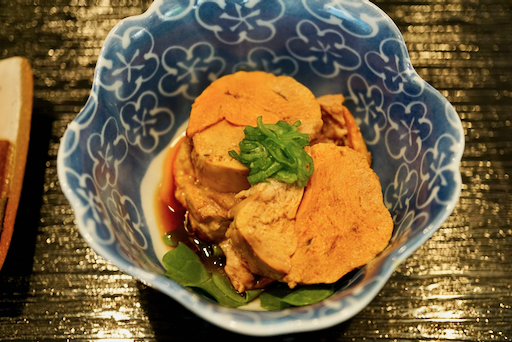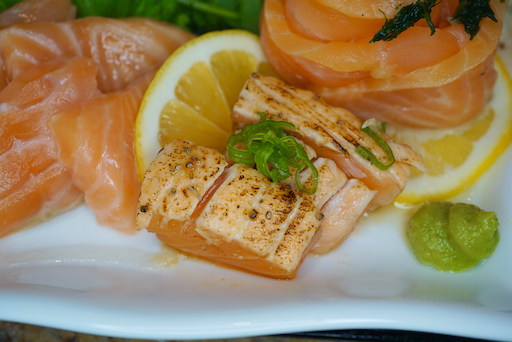We somehow feel really good that we can get Japanese food items from our Japanese grocery store again. It made us feel like there may be light at the end of this covid tunnel. We really like to start our evening with a little bit of sashimi.
Tuesday, June 15, 2021
Sashimi from Japanese grocery store 日本食料店からのはまち刺身
We somehow feel really good that we can get Japanese food items from our Japanese grocery store again. It made us feel like there may be light at the end of this covid tunnel. We really like to start our evening with a little bit of sashimi.
Sunday, May 16, 2021
Salmon "ruibe" frozen sashimi 鮭のルイベ
One evening, we wanted to have one more appetizer to go with the cold sake we were enjoying. I remembered that we had frozen sashimi-grade salmon from Catalina Offshore products in the freezer but it was a one pound piece and would take too long to defrost. Then, it occurred to me that we could have "ruibe" ルイベ which is frozen raw salmon shaven into thin pieces to eat as a kind of sashimi. This dish is supposedly derived from the way the indigenous people who lived in Hokkaido 北海道 known as "Ainu" アイヌ used to eat salmon. Since I am originally from Hokkaido, I was familiar with this dish. In the “old” days salmon harvested in the fall could be stored frozen during the hard cold Hokkaido winter without the need for modern freezers. My understanding is that the Ainu people just shaved pieces off the frozen salmon and ate the shaved pieces. (Hopefully, the long and deep freezing in the cold Hokkaido winter was sufficient to kill the parasite endogenous to salmon making it safe to eat raw.) The salmon we had was sashimi-grade and frozen, (also from Norway ??) so it is safe to eat. Thus the only question was "Could I, in fact, shave pieces off the frozen salmon?" So I tried it using a heavy chef's knife. Amazingly, I could as shown in the next picture.
When I served this it was still frozen but quickly melting on the edges. We dipped the slices in soy sauce with wasabi. It quickly melts when held momentarily in the mouth. Initially it is crunchy ice coldness followed by the slow unfolding of fresh salmon taste; quite a unique and interestingly pleasant sensation not previously experienced elsewhere. We found this is a very good way to enjoy salmon sashimi “on the fly” without having to thaw it ahead of time.
Tuesday, April 13, 2021
Sashimi big eye tuna "akami" and "Hotaru-ika" firefly squid メバチマグロの赤身とほたるイカ
Spring is the season for a species of small squid called "Hotaru-ika" ほたるイカ or Firefly squid. It is so-called because it emits a bioluminescent light like a firefly. Some years ago when we traveled to Kanazawa 金沢 and Kyoto 京都 in spring, we really enjoyed “Hotaru-ika” at various Izakayas 居酒屋. Because this squid has parasites, it must be cooked (boiled) or frozen at -30C for 4 days. That means a regular home freezer (-22 C or 0F) is not adequate. This is not a “ DIY (do it yourself ) home project”. The squid has to come from a commercial source with the resources to at least freeze it properly. While in Kanazawa, we learned, through multiple tastings that our favorite way to eat it is “Okizuke” 沖ずけ. Although this dish is made of uncooked marinated squid it is special to Toyama prefecture 富山県 (Kanazawa city is the capital) where they know to make it safe by appropriately freezing it before making it into okizuke 沖ずけ. “Oki-zuke” literally means “offshore marinated”. Traditionally, fishermen took the marinade with them on the boat and as they caught the squid , threw it into the marinade. By the time, they got back to shore, it was perfectly marinated. Although traditional, this method is not safe since the parasites will not be killed in a marinade.
In any case, recently, I mentioned to my wife (who is particularly fond of firefly squid), that it was the season and I was reading that many of the food bloggers I follow, were enjoying this seasonal delicacy. We had hotaru-ika at Tako Grill some years ago so we thought we should be able to get this in the U.S. A quick search of the internet turned up a company called “Regalis food”. They sell boiled firefly squid among other gourmet food items. They are more geared up for supplying restaurants rather than individual customers, however, so the minimal amounts required for purchase are a bit large. Nonetheless we ordered the minimum 300 grams (or three trays) of boiled firefly squid (which was shipped from Long Island) and the minimum 3 lbs. of big eye tuna akami (which was shipped from California). Although coming from different places both shipments arrived at the same time; (over night delivery).
The first picture shows one of the trays of hotaru-Ika.
Sunday, April 4, 2021
Hanami 2021 with healthy 4 Japanese appetizers 花見 2021
Wednesday, January 13, 2021
New year's eve sashimi 2020 年越しの刺身
For New Year's eve, we started with this sashimi. I ordered Atlantic tuna toro 鮪とろ, octopus leg 蛸, and ikura イクラ (all frozen) from Catalina offshore products at least a month ahead of time because last year I waited too long and when I got around to ordering sashimi for New Year they were sold out. I also got sashimi-grade salmon but it was a large piece and would have been too much so I did not thaw it. The toro piece was small (5oz) but enough for two of us. It contained "ootro" 大トロ and small portion of "chutoro" 中トロ. The octopus legs appeared to have been imported from Japan.
Monday, December 14, 2020
Sushi Taro "regular" kaiseki box "普通”の寿司太郎会席弁当
Tuesday, October 13, 2020
Special take-out Kaiseki box from Sushi Taro 寿司太郎のテイクアウト特製会席弁当
Prior to COVID the omakase counter at Sushi Taro was our special-occasion-go-to place. As a matter of fact, we had a reservation in March this year but because of COVID, that got canceled. I knew for some time that, although the restaurant was closed, Sushi Taro has been doing take-out. But getting there either from home or work for the pick-up was impractical. Since I started thinking about the NewYear “Osechi” 御節 from Sushi Taro, I contacted them. I was delighted to find out that they are going to do Osechi for the next New Year and I quickly placed an order. During that interaction, I learned that they do special omakase kaiseki boxes-to-go and that they can deliver. I quickly placed an order. Delivery was scheduled for Friday at 5pm. We were like little kids in anticipation. I even "just happened" to come home from work a bit early for the delivery. It arrived in two, two-tiered (bento or modified jubako?) boxes. (a total of four boxes with three compartments each). We initially thought we got two identical sets but when we opened the second box, surprise! We were totally blown away. All compartments contained many wonderful different dishes. The first one had some cooked dishes, two different kinds of sushi. The cooked dishes in the top tier were still warm.
Wednesday, September 16, 2020
Marinated tuna sashimi with grated Daikon 鮪のおろし和え
This is a continuation of the “using up yellowfin tuna sashimi block”. We started with “Tuna caprese” and proceeded with the cold chawan-mushi. This was the third appetizer and second tuna sashimi dish. Without knowing specifically what I would make, I marinated 1/3 block of tuna sashimi “saku” block sliced in concentrated Japanese noodle sauce or “mentsuyu” 麺つゆ to make “Zuke tuna” 漬けマグロ. I could have served as it is or as “yama-kake” 山かけ but I did not have any nagaimo 長芋. I did have daikon 大根, however, so I made this dish.
Thursday, September 10, 2020
Tuna sashimi caprese with basil and perilla 漬けマグロのカプレーゼ
Ingredients: (for an appetizer for two)
1/3 tuna “saku” block, sliced into 6 slices (3 slices per serving)
6 slices of fresh mozzarella cheese
6 basil leaves
6 perilla leaves (if large cut into two)
Good olive oil (I used our favorite Spanish olive oil)
Salt and pepper
Marinade:
2 tbs soy sauce
1 small clove of garlic, crushed using a garlic press (or grated from tube).
1/2 tsp. sugar
Directions
Add the marinade and the tuna into a Ziploc bag, remove the air, seal and marinate for 10-15 minutes. Blot out excess marinade (I decided to cut one slice into two so that I could make the basil and perilla versions). Layer the mozzarella cheese, tuna, and either basil or perilla. Sprinkle with the olive oil, salt, and freshly cracked black pepper.
This was a really good way to have tuna sashimi. The addition of garlic in the marinade made it really good. Both the basil and perilla versions while different were good. We thought both are good but the perilla ones had stronger and more distinct flavor.
Monday, July 13, 2020
No knead rye bread 捏ねないライ麦パン




















































